AMD’s 5 GHz Turbo CPU in Retail: The FX-9590 and ASRock 990FX Extreme9 Review
by Ian Cutress on August 9, 2014 8:00 AM ESTCPU Benchmarks: Comparing the AMD FX-9590
The dynamics of CPU Turbo modes, both Intel and AMD, can cause concern during environments with a variable threaded workload. There is also an added issue of the motherboard remaining consistent, depending on how the motherboard manufacturer wants to add in their own boosting technologies over the ones that Intel would prefer they used. In order to remain consistent, we implement an OS-level unique high performance mode on all the CPUs we test which should override any motherboard manufacturer performance mode.
It is worth noting that the FX-9590, against the A10-7850K for example, has double the threads and +1 GHz of core speed, despite the generational gap. Considering only these factors, the FX-9590 is most likely similar if not better at single threaded performance, but also 2x for multithreaded results.
HandBrake v0.9.9: link
For HandBrake, we take two videos (a 2h20 640x266 DVD rip and a 10min double UHD 3840x4320 animation short) and convert them to x264 format in an MP4 container. Results are given in terms of the frames per second processed, and HandBrake uses as many threads as possible.
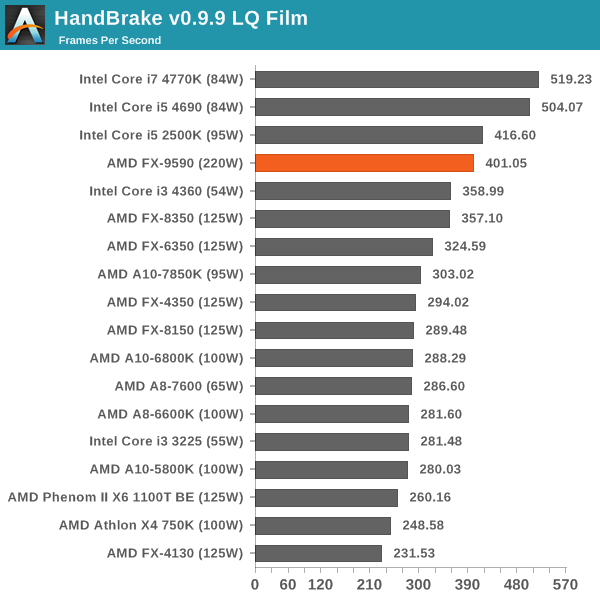
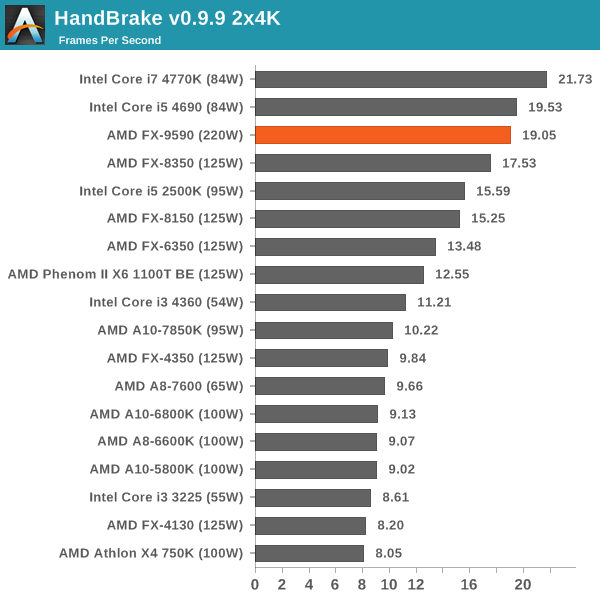
The eight threads of the FX-9590 give it almost another third of performance over the A10-7850K for small frame videos and nearly 2x for the larger frame conversion.
Agisoft Photoscan – 2D to 3D Image Manipulation: link
Agisoft Photoscan creates 3D models from 2D images, a process which is very computationally expensive. The algorithm is split into four distinct phases, and different phases of the model reconstruction require either fast memory, fast IPC, more cores, or even OpenCL compute devices to hand. Agisoft supplied us with a special version of the software to script the process, where we take 50 images of a stately home and convert it into a medium quality model. This benchmark typically takes around 15-20 minutes on a high end PC on the CPU alone, with GPUs reducing the time.
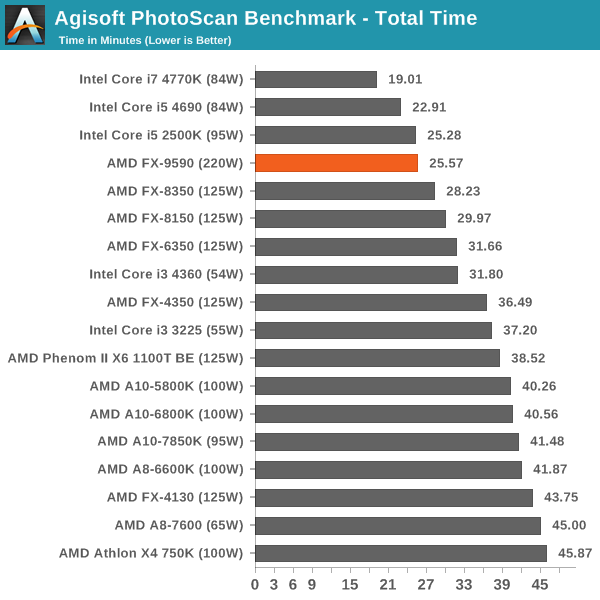
The FX-9590 puts in the best AMD CPU performance, similar to that of the i5-2500K.
Dolphin Benchmark: link
Many emulators are often bound by single thread CPU performance, and general reports tended to suggest that Haswell provided a significant boost to emulator performance. This benchmark runs a Wii program that raytraces a complex 3D scene inside the Dolphin Wii emulator. Performance on this benchmark is a good proxy of the speed of Dolphin CPU emulation, which is an intensive single core task using most aspects of a CPU. Results are given in minutes, where the Wii itself scores 17.53 minutes.
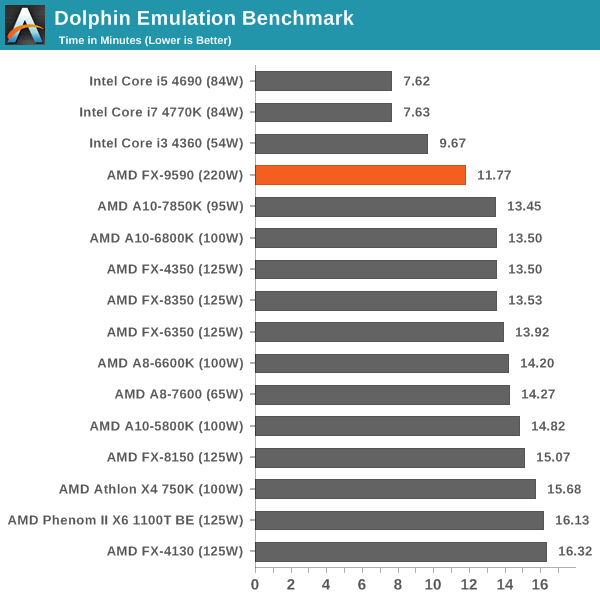
The FX-9590 beats almost everything pre-Haswell, showing the strength of a 5.0 GHz turbo mode. Note that it compares to the 3.5 GHz, 4MB L3 cache Haswell, which is 1.5 GHz slower and has half the L3.
WinRAR 5.0.1: link
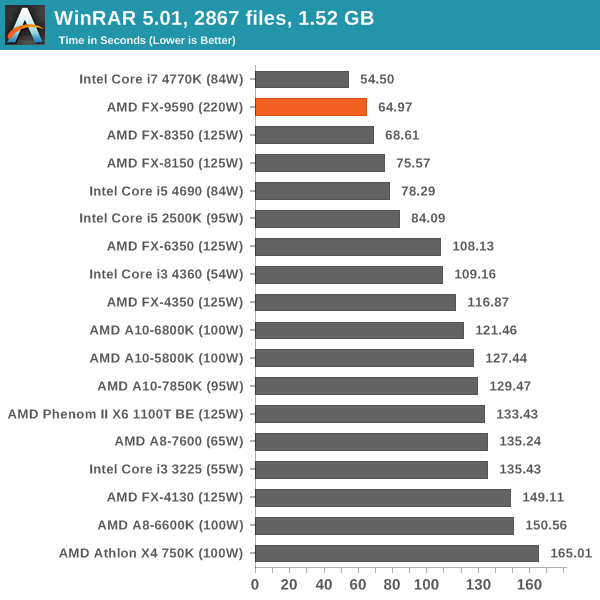
PCMark8 v2 OpenCL on R7 240
A new addition to our CPU testing suite is PCMark8 v2, where we test the Work 2.0 and Creative 3.0 suites in OpenCL mode.
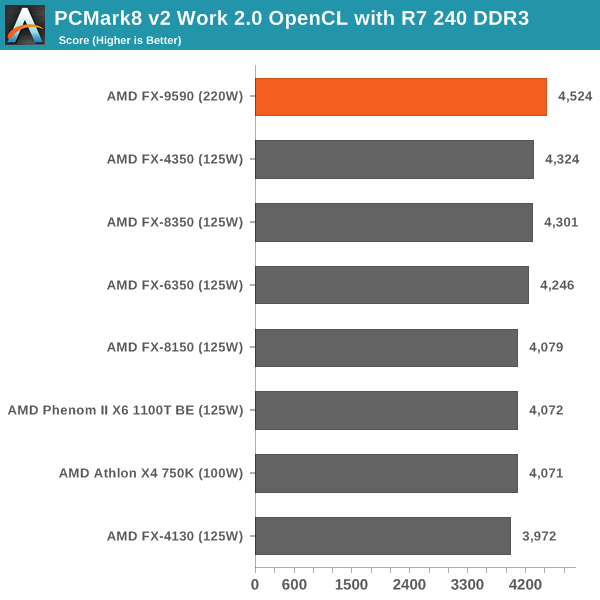
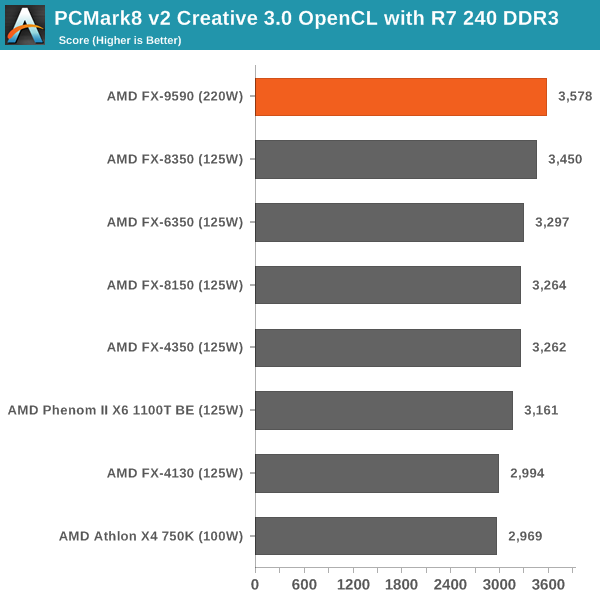
Hybrid x265
Hybrid is a new benchmark, where we take a 4K 1500 frame video and convert it into an x265 format without audio. Results are given in frames per second.
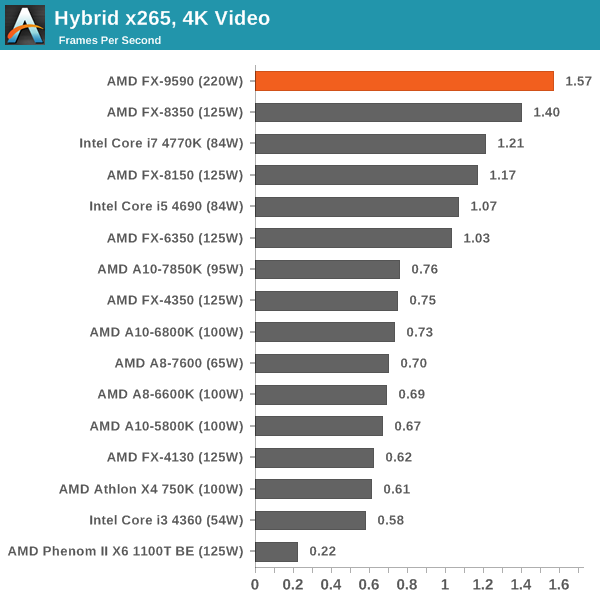
The FX-9590 holds up very well in the Hybrid x265 conversion, which makes me wonder how well an 8-thread Kaveri CPU would perform.
Cinebench R15
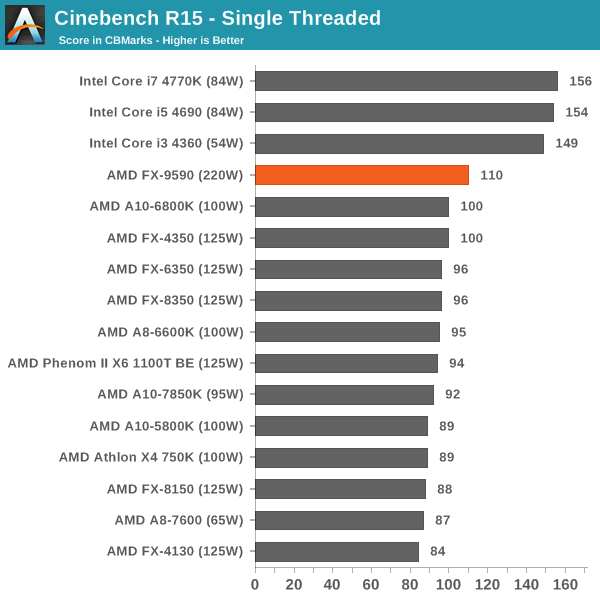
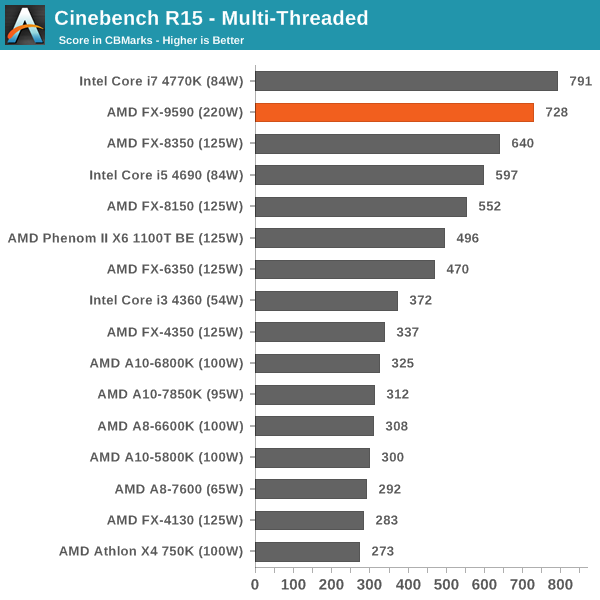
The FX-9590 still has the single thread edge over the newer AMD CPUs due to the high frequency, but is easily overtaken by the modern cheap Intel CPUs. For multithreaded competition, the 8 threads needs an 8 threaded Intel CPU to compete.
3D Particle Movement
3DPM is a self-penned benchmark, taking basic 3D movement algorithms used in Brownian Motion simulations and testing them for speed. High floating point performance, MHz and IPC wins in the single thread version, whereas the multithread version has to handle the threads and loves more cores.
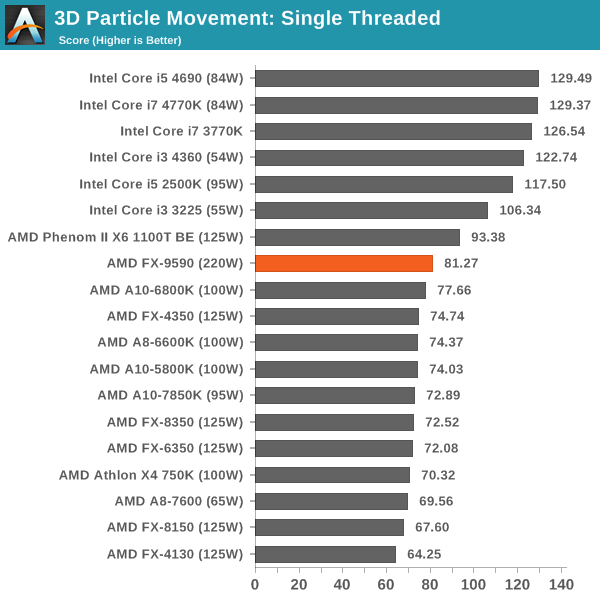
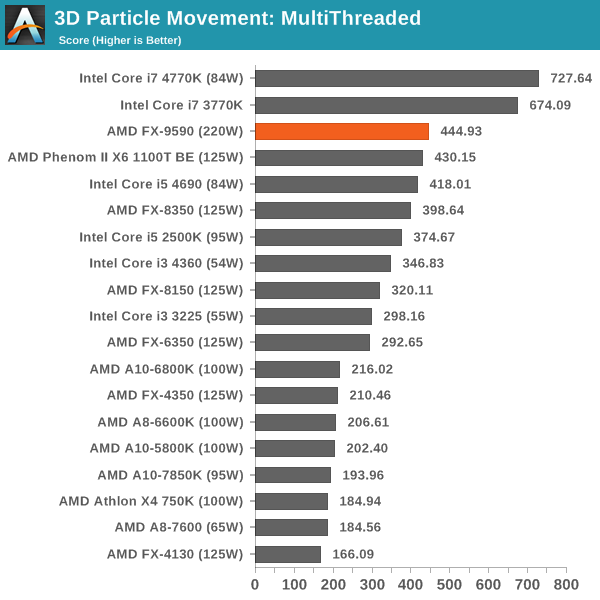
Although the FX-9590 again performs as the best AMD CPU, the floating point nature of the calculations in this test seems not to be favored by this architecture.
FastStone Image Viewer 4.9
FastStone is the program I use to perform quick or bulk actions on images, such as resizing, adjusting for color and cropping. In our test we take a series of 170 images in various sizes and formats and convert them all into 640x480 .gif files, maintaining the aspect ratio. FastStone does not use multithreading for this test, and results are given in seconds.

Similarly to 3DPM, for basic photo conversion any base 3.2 GHz Haswell CPU can outperform a 5.0 GHz AMD.










146 Comments
View All Comments
wurizen - Saturday, August 9, 2014 - link
the fx series does need to go down in watts, which only comes in a die shrink from what i know. but the thing it has going for it are 8 cores, which intel doesn't even have in their consumer or enthusiast cpu's. u have to go xeon to find an intel 8 core cpu. my theory that amd is not updating the fx series or their chipsets is probably due to the backlash of the of fx series. i forgot when the the fx-8150 came out but it was negative. i don't think amd wants to have another repeat of that so amd is putting their cards back in the deck. they're softly announcing this and that about apu's... and hoping the marketing of apu will be enough to garner positive feedback. bring the image back. that is all it is, i think. what the hell is an apu, anyway? oh, it's the future. this is what amd wants ppl to know. but, we know that apu is not the future. it's just a stop gap for amd. it's just a fancy acronym.i don't think the low performance of amd fx cpu compared to an intel part is also solely amd's fault. i think software developers/coding can also be attributed to it. i mean, if you have this and that code built for intel chips since they're inside (i hate to say it) most of the pc's in the world, then of course, intel will have a lead from the get go. for example, windows 8 is suppose to be better for amd fx cpu's than windows 7. now dig deeper into how programs are run and make it so that an fx chip will shine as much as an intel chip, then we probably have a very well optimized program, which in the real world is probably a unicorn program. so, this unicorn program puts both amd and intel chips thru its paces, equally and optimally and fully. and i think that unless an intel chip has a specific function that makes it run faster (i forgot what it is), then an amd fx 8-core chip with its more logical, fully functional, real cores of 8 will probably be better than intels 4 cores with hyperhtreading. intel has patents for those specific, specialize tasks though and this is why intel is hard to beat and why amd loses to them.
this is why amd is waiting b/c 1)amd knows intel's roadmap and 2)they have apu's and consoles as stop gap 3) they'll return to the desktop performance cpu when the tide, the program/software/patents or whatever it is has leveled out so that amd can put out a competitive product that is truly innovative. and not just tick and tocks 4) the cpu fabs are probably too expensive right now for amd to jump in and do a die shrink (not sure tho; maybe intel has a hand in that too? idk)--like why is intel the only cpu company doing die shrinks every year and half? sounds weird to me. and it's closest competitor is just sitting back. weird right? anyway, im out of theories, i think.
oh, you'd think amd would just put 8 core kaveris without an igpu, right? but, no. i think amd is still not sure the performance gain with that will be enough to wipe out the negativity of the fx-8150 debacle. so, amd is just not doing it.
what do you guys think of my theories?
Death666Angel - Sunday, August 10, 2014 - link
"but the thing it has going for it are 8 cores, which intel doesn't even have in their consumer or enthusiast cpu's."I stopped reading right there. If you think 8 cores in a 4 module FX CPU are comparable to 4 cores in Intel mainstream CPUs or 8 cores in Intel enthusiast CPUs, you should go back and read up on the architecture differences. The fact that an Intel 8 thread CPU (core i7 with 4 cores and HT) usually beats any FX CPU with 4 modules should be warning enough that you shouldn't draw any conclusions based on that.
wurizen - Sunday, August 10, 2014 - link
Ive read up on bulldozer architecture. 4 modules with 2 logical and physical cores = 8 cores. Intels hyperthreading arent physical cores but software driven. so an OS sees an i7 with 8 cores even tho 4 of those cores are virtual. AMD has 8 physical/logical cores. Each module or 2 cores do have to share FpU, l2 cache (i think) and another thing. So, the cores are hampered by this but it doesnt take away the fact that there are 8 cores there. And i know its slow even though it has more cores than intel. But by refining it and better software optimization, i am wishing AMD to at least compete with intel enthusiast x99 chipset in the future with half the price. Why? Bc i cant afford intel. Simple as that.mapesdhs - Tuesday, August 12, 2014 - link
Sorry it's not an 8-core at all, not when it has to share resources split int vs. fp. Hence whythis very article shows again and again the older 4770K beating the 959 on threaded loads,
with 60% less power consumption. Convincing yourself that AMD's "8 cores" marketing has
any kind of sensible basis is as bad as believing MHz is an equally useful metric, or MIPS.
Intel's real, old, 6-core, the 3930K, utterly demolishes the 9590, for less power, etc. If you're
on a budget, buy a used 3930K, it'll leave AMD's chips in the dust, and there are plenty of
low cost X79 boards these days, especially on the used market (Gigabyte UD3 only cost me
55 UKP).
Ian.
Budburnicus - Wednesday, January 14, 2015 - link
Noob, 2x ALU per unit DOES NOT equal 2 FULL CPU cores! The ONLY "edge" AMD has gained by this, frankly, AWFUL architecture, is in marketing, because they can somehow LEGALLY call each unit 2 CPU cores - when they do not function as such at all! In fact, HyperThreading provides better real world performance that doubling APU's when the architecture involved has much higher IPC as well as a DEDICATED minimum of 168 GB/s to L3 cache per core, at stock speeds!AMD calling a 4 unit CPU an 8 core machine is essentially the same as intel calling a 4 core i7 an 8 core CPU! HyperThreading is NOT software! read more about CPUs bro.
Budburnicus - Wednesday, January 14, 2015 - link
*than doubling ALUs*Budburnicus - Wednesday, January 14, 2015 - link
EXACTLY! +1Laststop311 - Monday, August 11, 2014 - link
you said intel has no non xeon 8 core cpu's. But haswell-e will have 8 core/16 thread. I currently run an i7-980x gulftown x58 system and will be replacing it with 8 core haswell-e. video production speed should sky rocket.mapesdhs - Tuesday, August 12, 2014 - link
That depends on what you're doing, which app, where the bottlenecks reside, etc.If you've already oc'd your 980X then you're starting from a pretty good baseline,
so don't expect HW-E to be that much better (NB: I have a 990X, a couple of 3930Ks,
4820K, seveal 2700Ks, etc.)
What really will help for you is the newer I/O provision, ie. SATA3, PCI Express, M.2, etc.
The non-Intel SATA3 controllers on X58 boards were pretty awful, especially Marvell.
And of course you can at least double your max RAM, which might be holding you back
somewhat if you're a heavy AE user.
Ian.
Arbie - Sunday, August 10, 2014 - link
I think 'ur' Shift key is broken.